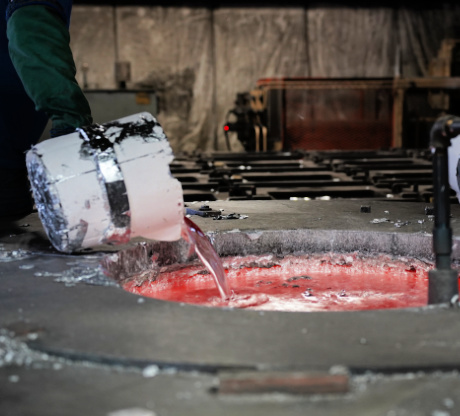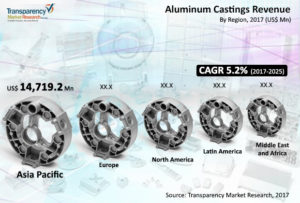Aluminum Castings Company Things To Know Before You Get This
Aluminum Castings Company Fundamentals Explained
Table of ContentsThe Only Guide for Aluminum Castings CompanyThe 6-Second Trick For Aluminum Castings CompanyAluminum Castings Company Things To Know Before You BuyAluminum Castings Company for DummiesThe Greatest Guide To Aluminum Castings CompanyThe Facts About Aluminum Castings Company UncoveredHow Aluminum Castings Company can Save You Time, Stress, and Money.Aluminum Castings Company Can Be Fun For Anyone
There are two key kinds of die spreading used in the light weight aluminum spreading market: hot chamber die casting and cool chamber die spreading. The main difference between these methods is exactly how the molten metal is supplied to the mold and mildew. In hot chamber die spreading, commonly utilized for reduced melting factor steels, the melting pot is straight attached to the machine, and a plunger compels the product via a gooseneck right into the die tooth cavity.
6 Easy Facts About Aluminum Castings Company Explained
In these methods, the mold and mildew is intentionally ruined or broken away in order to draw out the finished aluminum spreading. Usual processes under the classification of expendable mold casting consist of (investment casting),,, and investment spreading. When making personalized light weight aluminum components making use of expendable mold and mildews, suppliers put molten aluminum or aluminum alloys right into the mold, which is after that busted apart to launch the strengthened metal component.
The is among the oldest and most favored kinds of aluminum spreading. It involves condensing specialized foundry sand, often strengthened with clay or resin, around an exactly crafted recyclable pattern that determines the form and inner details of the finished aluminum item. The pattern system includes risers and vents to take care of the circulation of molten steel and to stop casting problems such as contraction porosity.
The Greatest Guide To Aluminum Castings Company

This mold is after that preheated previous to the pouring of liquified aluminum or light weight aluminum alloy. As the steel fills up the covering, it catches the intricate information and fine surface area coating of the mold. Once cooled down, the ceramic is mechanically or chemically escaped, allowing for the elimination and splitting up of individual cast components.
Aluminum Castings Company Can Be Fun For Everyone
Permanent mold spreading uses recyclable metal molds and is excellent for automation with consistent high quality and less waste. Expendable mold spreading utilizes single-use molds, like sand or foam, supplying style flexibility and lower tooling expenses for models or short runs. Pass away casting is best for creating high volumes of light weight aluminum components that need limited resistances, fine information, and smooth surface areas.
The Carat weight features innovative control systems for precise process management, consisting of automated ladling, real-time high quality control, and energy-efficient procedure. The Toshiba Machine DC-J Collection consists of pass away casting devices appropriate for aluminum. Known for their robust building and construction and high shot performance, these machines make sure reliable and accurate spreading. They feature innovative hydraulic and control systems for constant high quality, in addition to real-time tracking, automated lubrication, and easy to use programming user interfaces.

While light weight aluminum can be made use of in its pure kind, it is frequently alloyed with various other steels to enhance its buildings or the residential or commercial properties of the various other metals. These alloys offer boosted performance for numerous applications. Aluminum alloys are categorized into 8 collection, numbered from one to 8. The very first number(s) of the number show the primary alloying element combined with aluminum.
Our Aluminum Castings Company Statements
This alloying improves the strength and hardness of aluminum yet reduces its ductility and rust resistance. The 2000 series alloys are testing to weld but can be warmth dealt with to boost their homes. The 3000 collection alloys are largely alloyed with manganese. This mix improves deterioration resistance while giving modest strength.
Additionally, it includes high ductility and a really smooth finished surface area. The 4000 collection alloys are alloyed with silicon, which lowers the melting point and boosts fluidity. This makes it a prominent option for spreading, as it is simple to develop in its molten state. The 4000 collection is also frequently utilized as a filler for welding and brazing applications.
The Best Strategy To Use For Aluminum Castings Company
This series is categorized as a high-strength alloy, specifically matched for sheet and plate applications because of its exceptional weldability. Its resistance to deterioration from acids and antacid makes it perfect for usage in extreme and hostile settings (Aluminum Foundry). The 6000 series alloys are alloyed with both magnesium and silicon, supplying an equilibrium of stamina, mechanical homes, and corrosion resistance
Processing the 6000 series requires specialized and innovative equipment, which can be complex and pricey. This collection is understood for its outstanding deterioration and oxidation resistance, as well as its convenience of coating, therapy, and workability. The 7000 collection light weight aluminum alloys are the toughest and most resilient among light weight aluminum kinds, with toughness equivalent to about two-thirds of industrial-grade A3 steel.
An Unbiased View of Aluminum Castings Company
Zinc is the key alloying element in the 7000 collection, boosting the solidity of the light weight aluminum, although zinc's hardness is similar to that of light weight aluminum on the Mohs range. The 8000 collection aluminum alloys are primarily alloyed with tin, together with percentages of copper and nickel (Metal Foundry). While these alloys provide lower strength contrasted to other collection, they succeed in machinability and wear resistance
Aluminum cast heatsinks are electrically conductive, enabling them to be grounded effectively. They are usually cast with integrated attributes that minimize the need for additional operations, such as added machining or assembly, leading to more price financial savings. Light weight aluminum spreading is frequently used to produce braces for both durable industrial tools and household appliances.
All about Aluminum Castings Company
The single-piece building and construction of light weight aluminum braces improves their toughness and longevity, lowering the possibility of check my blog failure. If openings are needed, they can be included straight in the casting mold, lessening the requirement for post-production finishing (https://k12.instructure.com/eportfolios/1112342). Producers have actually progressively adopted light weight aluminum spreading for golf tools because of its durability, security, and convenience in shaping